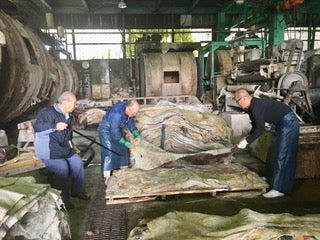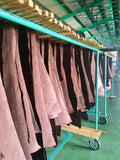
The colour of the huge dye vats in the Cordovan leather tannery in Kobe are the most strikingly pretty green. Together with the wooden vats and tubs, the ensemble of vintage colour and patina tells the story of decades of work in this industrial shed.
When you look more closely, one object which grabs your attention is the large stack of animal hides piled near the vats. Upon closer viewing, the hides are large panels of roughly animal skins, still showing clumps of hair and fat. These are horse hides, with each crusty with a thick layer of white salt.
This scene is a long, long way from the polished shoes and handbags which sit upright on shelves in smart glass fronted stores.
This is where it begins. From a horse hide discarded by the horse-meat manufacturers in Europe. The hides are drenched in salt, stacked and shipped across the world. They’ve made their way to Himeji, a city near Kobe, near the coast in the south of Honshuu, the main island in Japan.
These hides have arrived at the hands of a master leather tanner, Nitta san Senior (Mr Nitta). His experienced eye still checks every hide as it arrives. This is Japanese craftsmanship at it’s best, where experience and attention to detail informs every step of the making process.

Nitta San Senior (Mr Nitta) inspecting the horse hides
Here at Cordovan they’ve been tanning and curing leather hides since the late 1930s. Nitta san’s (Senior) mother was widowed when her children were young and she found herself with no husband and no income and in a country about to enter World War 11.
She started tanning hides in her backyard as a way to make money at home while she was raising her children. There would have been very few opportunities for work for women with children. But leather manufacturing was a local industry and she discovered the opportunity to do something at home. Over time it grew and sustained the family.
Nitta San (Senior) learned everything from her from his childhood, helping her after school.
Now Cordovan sell the hides to bag, shoe and apparel manufacturers in Japan. They export biker jackets to the North American and Canadian market. One item they specialise in selling is leather hides to the makers of school back packs for children. They cut the perfect sized piece from the rear flank of the horse hide.
The hard leather backpacks are designed to last in Japan. Traditionally grandparents buy the backpack for their grandchild as a gift. An indication of how a culture views education and learning.
When Nitta San was old enough he took over the business, and now his adult children run it with him. Nitta san (Junior) was sent to France when he was fresh from school with no knowledge of the French language, to learn all about leather tanning processes. He said it was daunting, but a great way to learn the skills and a new language.
Nitta San (Junior) runs the day to day business, and works with his sisters and small staff, but his father remains President. (The Japanese tend to follow the American company structure with Presidents and Vice Presidents).
But it all starts with the hides. Without the careful studied attention given to each and every hide, the wallets, purse, handbags and children’s school backpacks would not be made.


stacked dry hides template for school backpack leather
This process is not a quick one. It takes 10 months to produce one hide. The hides arrive whole and are cut into 2 pieces – the front half and the back half of the animal. The front half are treated the same way as the rear, but the bottom, that muscular rump is what is prized.
The company name, Cordovan, refers to this piece of leather. It’s not just the shape or part of the animal, but the middle seam of leather which appears after the top thicker layer has been cleaned and tanned. After polishing, it shows no markings or bumps. It’s perfectly smooth.
But to achieve that requires several stages.
Soaking the Hides
Firstly, the Hides are soaked in vats and turned with water to rinse off the salt, then treated with a chemical rinse to dissolve the hair.


soaking vat hides next to the soaking vat

tanning vat with vegetable dyes, where the hides are soaking and agitated for over a week.
The clean hides are then ready for the main tanning phase. This can be done in two ways. The quicker and cleaner versions is with a “chrome” a chemical treatment bath) or the more time consuming vegetable dye tanning.
Tanning the Hides
At the Cordovan factory all the hides were chemically tanned but now, the trend has reversed and it’s about 30% “chrome” (chemical) and 70% vegetable dyeing.
The reason for the tanning is to prevent moulds and bacterial entering the fibre, and it prepares it to be used as a malleable materials which can be cut, stitched and moulded to shape.
The chrome (chemical) method takes the hides after they are cleaned. At this stage they are white, colourless, wet fleshy and a bit pock marked. They’re almost a bit off-putting, resembling the look of ‘brains’ I’ve seen in a butcher’s window display. They are now treated a second time and come out of the second ‘bath’ looking a pale blue. A little prettier, but still nothing remotely like leather we know.


- dry chemically-dyed hides wet, chemically dyed hides
Drain and squeeze the hides
The next step is to squeeze all the water out, so they are sent through a presser. This fellow managing the presser has set up a steady rhythm moving the large heavy pieces in and out perfectly timed with the presser. You wouldn’t want to distract him so his misses the beat.
Drying and dyeing the hides
The pressed hide now hangs to dry for about a month.


hides drying after tanning hides drying after tanning

stacked hides after a month of drying
The final step in the colouring process is when the hides are rolled on a slow conveyor belts dyeing spray machine, which colours the leather evenly automatically measuring how much each piece requires.
The hides are dried again and run under a new presser to keep the leather a neat “ironed” version of it’s former self. Then hung ready.


painted leather hanging to dry glass cylinder used for polishing

glass cylinder used for polishing
For the hides left unpainted, the final step before cutting is to polish. This step is intriguing. Glass is used to polish the leather. A “cone of solid glass, like a geologist’s core sample, is attached to a machine clamp, which is designed to move quickly back and forth about 5 cm in each direction to rub the glass across the surface of the leather. Within a few seconds the polished effect appears.
The worker, moves the leather in and out and around the moving glass block, making sure the whole surface is evenly polished. It is remarkable to watch the dull piece of leather be smoothed so completely so quickly.
Then it’s done. The smooth leather piece is either shipped off to the leather makers, or to the Cordovan makers to create their own items (wallets, bags, pouches) which are sold to upmarket department stores.
It’s a fascinating process seeing the transformation of a fleshy, hairy hide into a workable material which then creates a whole new product. It gives me a better appreciation of the true value of an item which can last a lifetime.


wallets being made wallets being stitched

wallet pieces ready to assemble

